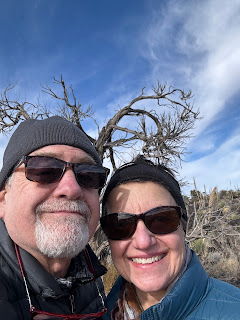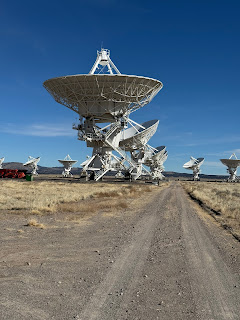A Very Large Array
*
Fleeing the subzero temps that plagued us through Texas we finally arrived in the high desert of central New Mexico. This state holds a very special place in my heart. It was here that as a young couple, with a new baby and two dogs, we were able to find a sense of place and begin to stitch our lives back together after a, seemingly insurmountable, loss. Sometimes I feel that the vastness of the horizon, the magical colors of the sunsets, and the clear view of the heavens above made us that much stronger.
Every time we return to this area I feel comfort in the red clay earth, the pinion and juniper, and the snow capped mountains that rise above the high Chihuahuan desert. And there is nothing like the sweeping expanse and the drop dead, picture perfect sunsets!
Valley of Fires Recreational Area
*
We are currently staying the week at the
Valley of Fires Recreation Area which is maintained by the Bureau of Land Management (BLM). Located just outside the town of Carrizozo, NM and at an elevation of 5,200’ the days are sunny, averaging between 50/60 degrees, while the nights can dip below 30. Surrounded by the Sacramento Mts to the east (snow capped Sierra Blanca rises to 11,973’) and the San Andres Mts to the west we are sitting in what is known as the Tularosa Valley. This valley is also home to White Sands National Park, located @ 60 miles to the south, and the Trinity atomic bomb site, @ 25 miles to the west.
Lava folds
*
Within this large valley sits the Tularosa Basin and it is here where the Valley of Fires is located. Approximately 5,000 years ago lava spewed from volcanic vents at the northern edge of the valley and flowed into this basin creating what is now called the Malpais Lava Flow. This lava flow is the youngest flow in the continental U.S. and is 4-6 miles wide, 160’ thick and covers 125 sq. miles! From a distance the Valley of Fires looks like barren black rock. However, as one walks through the nature trails you see many varieties of cacti, trees, flowers and bushes that have sprung up from the many collapsed lava bubbles, pits and fissures. The area is also home to many species of birds including roadrunners, cactus wrens, great horned and burrowing owls and golden eagles.
Happy campers! ❤️
A 400 yr old juniper tree
*
An array of The Large Array
The VLA is made up of 27 HUGE white dish shaped antennas that together create a huge “telescope”. These antennas are tuned to a kind of light on the spectrum that eyes cannot see - this invisible light comes to us in the form of radio waves. Cosmic radio waves are very faint and can travel for billions of years across space and can give scientists the data necessary to construct a timeline of the universe.
The VLA project began in 1972 and had 6 working arrays by 1977. By 1981 all 27 were completed. The antenna were all recently retrofitted (2012) in order to replace the old wiring with fiber optics and a new super computer was added. Each dish measures 82’ across and stands over 90’ tall. Motorized drives can steer them up and down in order to point them in the precise direction needed. Every 4 months transporters lift and relocate each dish to one of 72 new positions along a Y- shaped railroad track adjusting the scientific capabilities as needed.
Built on the Plains of San Agustin, at over 7,000’, the natural fortress of the mountains that ring the area protect the site and keep out much of the radio interference that can occur from cities even hundreds of miles away. As a visitor you are told to turn off all cell phones, watches, GPS, Wi-Fi, and other devices.
I guess I never fully understood that radio waves could be seen…..
mind exploding.
The night sky has been phenomenal this week and it has been so quiet and peaceful here. It will be a bit sad to leave ….. but we have more to discover!










No comments:
Post a Comment